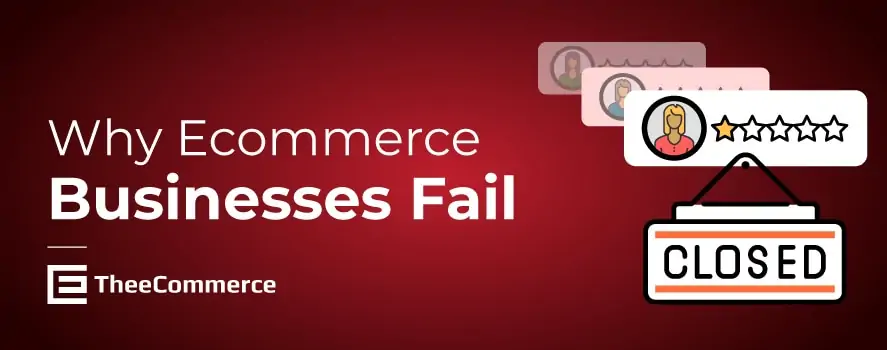Did you know 22% of ecommerce businesses fail in their first year?
How is this possible when 18% of all retail sales are online?
In this article, we’re going to show you why ecommerce businesses fail and how you can avoid being a bad statistic.
7 Reasons Ecommerce Websites Fail: The TLDR Version
Let’s get through the seven reasons ecommerce websites fail in “Too Long, Didn’t Read” (TLDR) style for those of you in a hurry. If you want to know more, click on any heading to jump to that section.

The Good News for Ecommerce Stores
Ecommerce is big business and it’s only going to get bigger. The percentage of retail sales that will be ecommerce is expected to grow to 22% in the next few years. No one can deny the widespread use of online shopping. The real trick is knowing how to use it to grow your business.
We’ve already given you the TLDR version. Now let’s do a deeper dive into each of those seven reasons so you can understand how to avoid problems with your business.
Ecommerce Startups Fail Because They Don’t Plan Their Startup Costs

Lack of investment is one of the main reasons why ecommerce launches come crashing down. Many people imagine they can start an ecommerce business for $50. While that may be true, it just isn’t realistic. There may be a unicorn success story like this, but it certainly isn’t common.
Instead, a new ecommerce store needs to plan its first steps to account for all the costs involved in launching an online store properly to break into the competitive retail market.
Solution – Develop a Realistic View of the Costs and Then Plan Capital Investments
To help you develop a better plan, we’ve put together a list of most of the areas of investment your new venture is going to need.
As you can see, this is a longer list and almost certainly can’t be accomplished for $50. Instead, you should start planning your cash flow around the big milestones.
Those three steps are common when starting an ecommerce business. You’ll need the cash flow to get through all three. After your first sales come through, hopefully there will be more capital to invest in growth.
Launching Without a Business Plan Leaves You Vulnerable to Retail Giants

Your business model should take account your customer base, product categories, and how your product offering differs from everyone else. That last one is about finding the right niche for your business. If you’re trying to sell everything to everyone, then your biggest problem is going to be retail giants such as Amazon, Wal-Mart, and eBay.
Instead, take time to consider what you’re going to sell, how to market it to people, and why anyone should buy your product in the first place.
Solution – Determine Your Niche
By having a specialty or a niche, you can target your ideal audience and sell unique products that won’t be found at a big box retailer. Do a bit of research to see how you can create a sought-after specialty.
Following these steps should get you off to a good start and take you through part of the process of launching your business.
Poor Ecommerce Website Design

Designing an ecommerce website with a few nice pictures to show off your products and hoping for the best sinks many business owners. Poor website design directly harms your conversion rates. To be successful, ecommerce businesses need to focus on developing websites that work beautifully.
Here are a few things you can focus on to get the best results.
Solution – Partnering with an Ecommerce Website Development Company
By investing in your website and working with a company who specializes in ecommerce website development, you can avoid failing due to a poor website. An experienced design team can work with you to create a great looking website that reflects your brand and looks professional while making sure it’s organized, secure, and quick to load. Visitors to your website will convert to customers, allowing your business to thrive.
Complicated Checkout Process

A complex or lengthy checkout process leads directly to cart abandonment. Customers frustrated by extra fields to fill in or confusing payment gateways will click away from the sales process. Your best plan is to make the checkout process simple and seamless.
Here’s how to design a checkout process that closes the deal effectively:
- Show off your security with visual cues such as security company icons and badges.
- Reduce the amount of typing your customers must do to complete the sale by using payment providers such as Amazon, Stripe, PayPal, and Google Pay.
- Don’t use any mandatory registration. Incentivize any registration with some kind of added value.
Implementing simple steps like these will make your checkout process much better for your customers. Lower shopping cart abandonment will directly cause an increase in sales and profits.
Solution – Streamline the Payment Process
Make sure your ecommerce web design includes a quick, simple checkout with popular payment gateways, like PayPal. Avoid having multiple payment screens, include the option to register with social media logins to save time, and build trust with a secure checkout.
You can design your own payment process, of course. However, there are many steps to be completed and you may benefit from expert customer support.
Poor Photography and Product Descriptions

Pictures sell products. Shoddy product presentation will drive customers away. Instead, use good photography and professional design services to make a superb impression on every user.
Pictures aren’t the only thing you need, of course. You should also describe each item you sell with an effective description and confident sales copy.
Pictures and sales copy will increase your marketing performance. Instead of running ads that bring in shoppers who don’t buy, use attractive pictures and effective sales copy to increase your conversion rate.
Solution – Adding Value to Your Brand with Quality Content
Adding multiple high-quality images of your products will make a great first impression. However, you also need to pair it with an in-depth, easy-to-scan product description that gives clear information and specifications while also connecting with the needs of your ideal customer.
While you can attempt these steps yourself, it may be better to partner with professional consultants to ensure consistent quality and results on every page.
Ecommerce Business Fails to Show Up in Search Engine Results

Research from PowerReviews is showing that 35 percent of shoppers begin their purchasing journey on a search engine. This is second only to Amazon for where the buying journey begins. For specialty and niche retailers, even more of their traffic comes from Google, Bing, and other search engines.
It’s impossible for an online store to stay open, much less experience success, if new traffic isn’t coming to their website. That’s why one of the biggest reasons an ecommerce business fails is because it’s not showing up on the first page of search engine results.
Solution: Ecommerce Search Engine Optimization
Ecommerce search engine optimization simply means leveraging key ranking factors to make a website more visible in search engine results.
- Using specific keywords in your product descriptions and throughout your website.
- Ensure your site’s performance meets expected standards. Site speed is a ranking factor, and it is almost entirely in your control.
- Publish a blog to capture more search traffic and generate leads.
Stores that do not look after their SEO will struggle to have the necessary traffic to generate sales. Traffic can be boosted by paid ads, but this could severely damage profit margins. Instead, work with a team of experts to boost your SEO and traffic.
Lack of Digital Marketing Strategy
A common misconception in ecommerce is that once the website is running and the inventory is ready for purchase, shoppers will start visiting the site. However, these business owners are missing a crucial step: getting the word out about the business and attracting customers to their new online store.
Even if a business utilizes ecommerce SEO best practices, it takes time to rise to a highly visible spot in search engine results. In the meantime, there’s no site traffic and the business is losing money.
Solution: Creating an Ecommerce Digital Marketing Strategy
There are multiple ways to build your online presence for your ecommerce business. Pay-per-click advertising for ecommerce businesses allows you to place ads on social media sites, search engines, and other sites, putting your business in front of a targeted audience.
Developing a strong social media presence where you’re providing valuable, relevant content to your ideal shoppers will also attract customers to your site. Consider posting blogs and spending time on social media sites where your target audience is most likely to be to build your brand.
Let TheeCommerce Help Your Ecommerce Business Thrive!
If you’re planning an online store or are struggling to gain traction in a crowded marketplace, TheeCommerce can help you stand out! We specialize in digital marketing strategies that increase visibility and attract your ideal customers and web design that provides an amazing shopping experience and converts your visitors into raving fans!
We can run a free website audit for your ecommerce business to help you create ways to attract more visitors and boost your sales. Reach out to us today at 919-336-1790 or fill out our contact form to get started!





